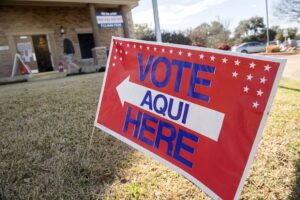With the votes in the contest between President Donald Trump and former Vice President Joe Biden being counted, New York — and New Yorkers — have much riding on the results.
Both Mayor Bill de Blasio and Gov. Andrew Cuomo have said they are waiting for a winner to be declared before deciding whether to retrench state government amid major pandemic-wrought revenue shortfalls. The two Democrats are clearly betting on a Biden victory.
People out of work, perhaps also worried about losing their homes to eviction, could see shifting prospects for aid. Also awaiting word from Washington are immigrants with temporary residency status in the U.S.
Meanwhile, how New Yorkers get around as the city tries to bounce back from the economic devastation of COVID-19 hangs in the balance.
Here’s a look at some of the high-stake challenges facing New York with the White House race in limbo:
State and City Battle Budget Woes
Both Cuomo and de Blasio have been banking on a Biden win in the hopes that the former vice president would shepherd a federal aid package through Congress to pump some much-needed funding into New York.
“I’m hoping that tomorrow is the beginning of a very new era for this country and for the city and where there’s the kind of stimulus we deserve, which would be a game changer,” the mayor said on NY1’s Inside City Hall Monday night.
Layoffs among New York City’s more than 300,000 municipal workers, however, remain a “last resort,” de Blasio said on Inside City Hall.
To salvage the cash-strapped city some money, City Hall is instead backing a proposal in Albany that would offer members of the city’s largest civilian union early retirement incentives — a move that’s expected to help save $900 million over the next four years, according to administration officials.
If Trump prevails or if the U.S. Senate remains under tight Republican control, the legal need to balance the city and state budgets could usher in austerity measures some fiscal hawks have said are already overdue.
Trump has also attempted to single out his hometown for financial punishment — most recently by issuing guidelines allowing federal agencies to deny certain funds to three cities his Department of Justice calls “anarchist jurisdictions,” including New York. The city is joining Portland and Seattle in a court challenge to that move.
Meanwhile, Biden plans to increase government spending to send aid to states, particularly New York, which absorbed the early brunt of the coronavirus pandemic.
“States have to balance their budgets under the law. … There’s a reason why the federal government is able to run a deficit: to compensate in times of real economic crisis,” Biden said at a news conference in Delaware Monday.
Unemployment Help Stalls
While the statewide unemployment rate fell to 9.7% in September from 12.5% the previous month, the number of people unemployed in New York remains higher than the national rate of 7.9%.
In New York City, the unemployment figures are grimmer with a 14.1% unemployment rate as of last month.
The Independent Budget Office estimated in July that the city will lose 560,000 jobs by the end of the year, only regaining about a quarter of those in the next three years.
The federal CARES Act provided an additional $600 a week to some collecting unemployment. But the benefit ended in late July and talks over a second stimulus package have sputtered, leaving many unemployed New Yorkers unable to make ends meet.
Last week, Trump told White House reporters that any stimulus package would have to wait until after the election while chiding House Speaker Nancy Pelosi for seeking aid to states. Meanwhile, Senate Majority Leader Mitch McConnell, who won reelection Tuesday, has said he wants a relief package at the beginning of next year, while Pelosi is pushing for one much sooner.
MTA Confronts Huge Service Cuts
Without a massive cash infusion from Congress, the MTA is likely to face a “unheard of service cuts and workforce reductions,” state Comptroller Tom DiNapoli noted in his yearly audit of the agency last month.
The MTA had already been strapped for cash before the pandemic hit in the spring. But the virtual overnight ridership fall exacerbated the agency’s financial woes and it now faces a $16.2 billion deficit through 2024.
Transit officials had been pushing Congress for a $12 billion bailout, warning that without the funding it would be “forced to take draconian measures, the impact of which will be felt across the system and the region for decades to come,” MTA Chair Pat Foye said in August.
In addition to huge service cuts, the agency would have to abandon much-needed upgrades — including bolstering the subway’s nearly century old signal system, which causes many of the system’s delays.
Failure to fund the subway system will have lasting effects and impede New York’s recovery as the city tries to get back to work, DiNapoli warned in his audit.
Tenants Face Rent Crunch
Residential evictions have been on pause since the early days of the pandemic in March. But as New York enters the eighth month of the outbreak, non-payment of rent has stacked up for some New Yorkers who have no way of paying the rising bill.
Meanwhile, landlord groups are warning that without rental subsidies or a reduction in taxes, property owners are left in the lurch by the eviction moratorium.
With the state facing a $59 billion revenue shortfall through 2022, funding for rental subsidies would have to come from Washington.
Last month, the Democratic-controlled House passed a $2.2 trillion package that included $50 billion in emergency funds to low-income renters at risk of losing their homes. But a more narrow stimulus bill in the Republican Senate contained no rental assistance funding.
Immigrants Grapple with Loss of Protections
For some immigrant New Yorkers, the stakes rise to their ability to remain in the U.S.
Some 15,000 New York City residents have Temporary Protected Status, which allows them to live and work legally in the United States.
Their lives were thrown into turmoil last month when a federal court ruled that the Trump administration could end the program. TPS recipients from El Salvador could stay in the country for at least a year, while New Yorkers who hail from Honduras, Nepal, Nicaragua and Sudan will continue to have the legal status for the next six months.
Those individuals, who have established families and businesses in the U.S., would be forced to return to their home country despite calling New York home, some for decades, or navigate life in the U.S. without legal status and documentation.
Also in limbo are beneficiaries of the Obama-era Deferred Action for Childhood Arrivals program, which shielded thousands of young immigrants from deportation.
Nearly 29,000 undocumented New Yorkers who came to the U.S. before the age of 16 are DACA recipients, allowing them to work legally in the country.
Roughly 650,000 DACA recipients, sometimes referred to as Dreamers, were granted a temporary reprieve in June when the U.S. Supreme Court ruled that the Trump administration couldn’t proceed with its plans to end the program because it was going about it the wrong way.
But the Supreme Court’s ruling offered the administration a blueprint on how to terminate DACA. In the months since, U.S. Citizenship and Immigration Services has rejected new applications and cut the lifespan of the program so applicants would have to reapply annually instead of every two years.
Biden has pledged to make the DACA program permanent on his first day in office. He’s also promised to reverse many of Trump’s immigration policies, including the creation of a wall along the Mexican border, while creating a pathway to citizenship for TPS holders and Dreamers.
This article was originally posted on What’s at Stake for New Yorkers, No Matter Who Wins the Presidential Election











More Stories
Milwaukee’s election boss needs to stop ‘getting out the vote’
Early voting under way for Texas primary election runoff
Thousands of Arkansas residents cast ballots before Tuesday’s primary